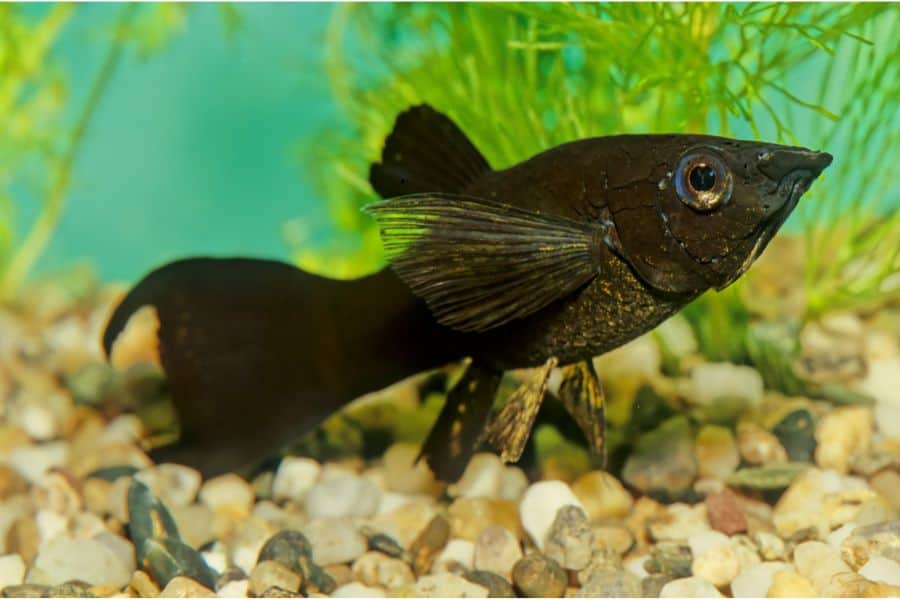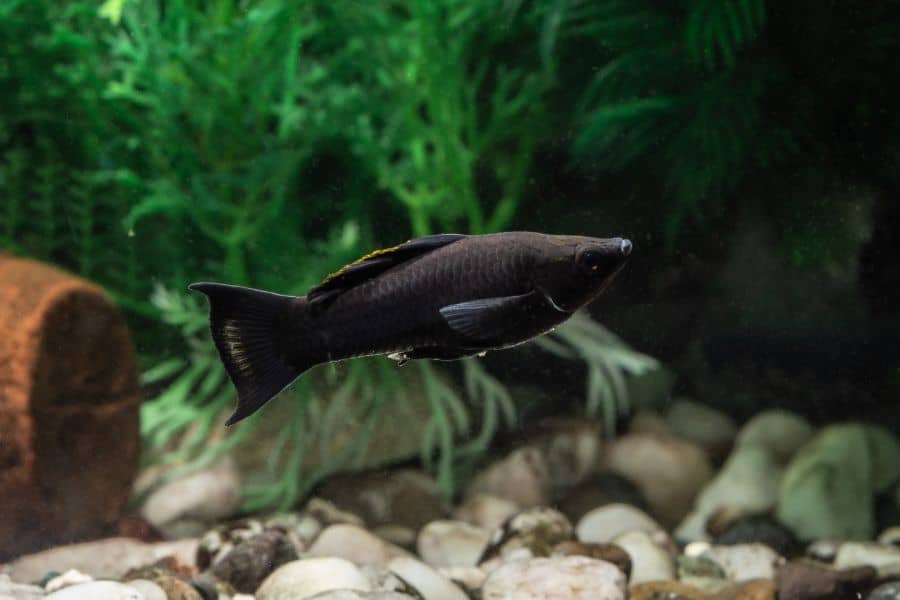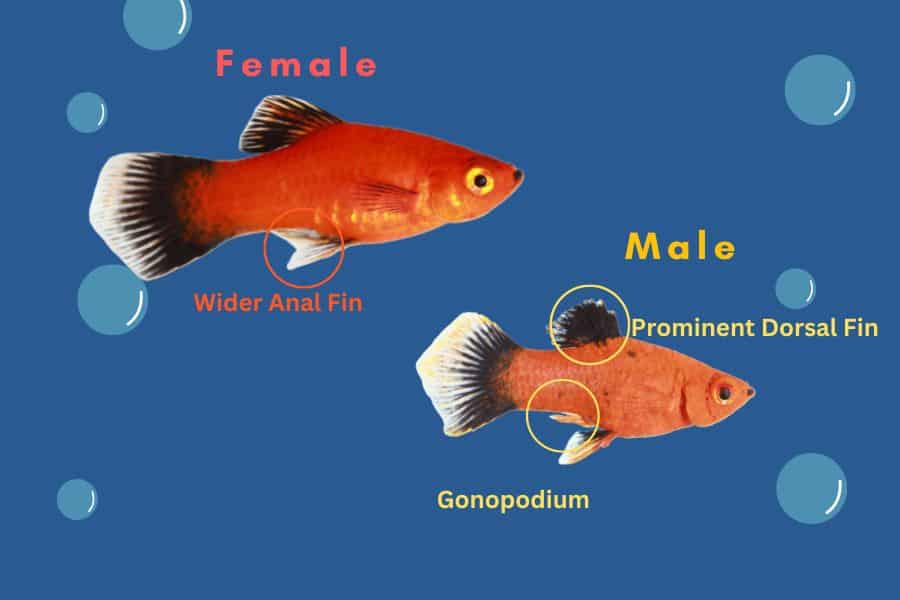Black molly fish are popular freshwater aquarium species recognized for their distinctive coloration and active nature. Originally from Mexico, Central, and South America, these fish belong to the Poecilia genus and have been bred to produce colorful patterns and colors over time.
Black molly fish are known for their hardy nature and adaptability to various water conditions, making them a great option for beginner aquarists.
In this article, we will discuss the physical characteristics of Black Molly fish, their habitat and distribution, breeding and reproduction, diet and feeding habits, tank requirements and care, behavior and temperament, as well as popular varieties and colors.
You will know more about these intriguing fish and how to take good care of them in your own aquarium by the time you finish reading this article.
Overview
| Scientific Name | Poecilia sphenops |
| Size | 3-5 inches |
| Life Expectancy | 3-5 years |
| Temperament | Peaceful |
| Diet | Omnivorous |
| Tank Size | 2-3 gallons of water per inch of fish; at least 50 gallons for 5 fish |
| Tank Temperature | 70-82°F (21-28°C) |
| Water Hardness | 11-30 dGH |
| Water pH | 7.0-8.0 |
The black molly fish belongs to the Poeciliidae family of freshwater fish. Native to Mexico, Central, and South America, these freshwater fish became part of the aquarium hobby during the early 1900s.
Black molly fish are descended from the original wild species Poecilia sphenops, which is distinguished by its deep, nearly black coloring. Breeders have developed a variety of colors and patterns in these fish throughout time, such as black, silver, gold, and white, by carefully selecting the parents of every new generation.
The black molly is a well-known choice among aquarium hobbyists nowadays, and there are lots of varieties available. Beginner aquarists should consider black molly fish for their hardiness and ability to adapt to a wide range of water conditions.
What Does the Black Molly Look Like?
It is simple to distinguish black molly fish from other fish species mainly because of their unusual look. The body size of these fish is relatively small; they typically reach a length of about 3-5 inches having a slender, cylindrical shape.
Black molly fish, as their name indicates, have a dark, almost black color all over their bodies. They have dorsal fins that are triangular in appearance and huge, rounded fins. Moreover, they have a broad and fan-shaped caudal fin, which gives the fish a graceful look when swimming.
Black molly fish might feature white or silver specks, spots, lines, or other body markings in addition to their black coloring. But, the black color is usually the prominent feature, giving these species their distinctive look.
What Is the Difference Between Male and Female Black Molly?
It is possible to distinguish male and female black molly fish from one another based on physical characteristics. Black molly fish males and females differ mostly in the following ways:
- Size: Black molly fish males and females are often somewhat different sizes. Males normally reach maximum lengths of roughly 3 inches; on the other hand, females can grow up to 5 inches.
- Body shape: Female black molly fish have a rounder, more robust body shape than males. It is more obvious when a woman is pregnant since her belly will enlarge substantially.
- Fins: Compared to female black molly fish, males often have longer, more pointed dorsal fins. Additionally, they possess a gonopodium, a fin utilized specifically for reproduction.
- Color: Male and female black molly fish do not consistently have different colorations; however, sometimes the males may seem a bit more vibrant or bright.
Generally, it can be difficult to distinguish male and female black molly species with confidence due to their slight differences.
Lyretail Black Molly
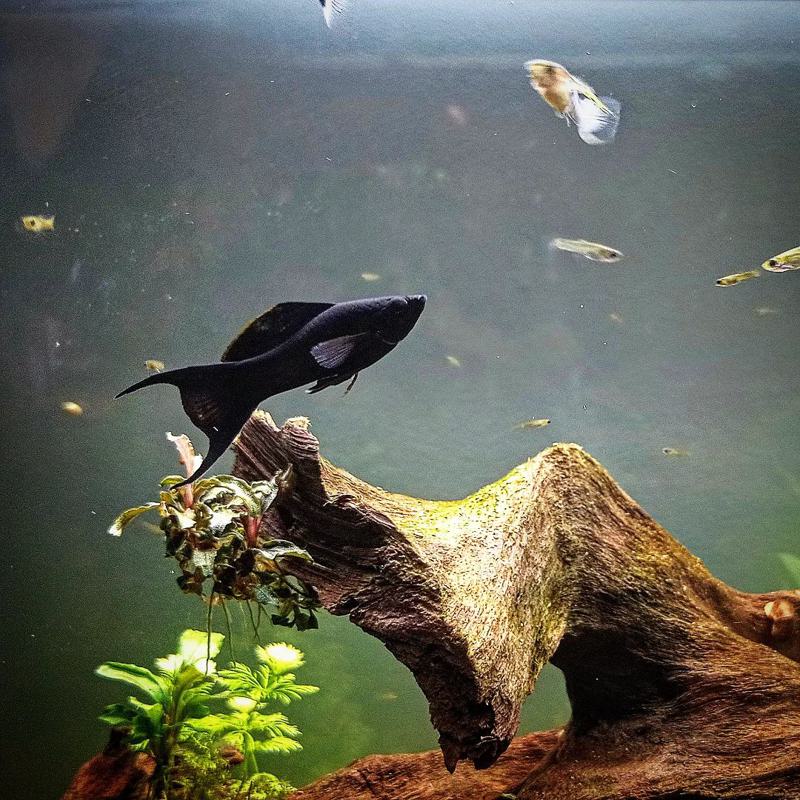
Lyretail black molly is a popular variation of black molly fish with a unique tail fin. The lyretail black molly has a long, lyre-shaped tail fin as opposed to other black molly fish, which have fan-shaped tail fins. It gives the fish a graceful, flowing appearance when swimming.
Unlike other black molly fish, lyretail black mollies are identified by their distinctive tail fin and exhibit a similar dark, almost black coloration. Silver, white, or orange patches, as well as various hues or patterns, may be present on their body.
Lyretail black mollies, like other black molly fish, are resilient and adaptable to a variety of water conditions. They are omnivorous, eating flake and pellet meals as well as live or frozen brine shrimp or bloodworms.
How Big Does a Black Molly Get?
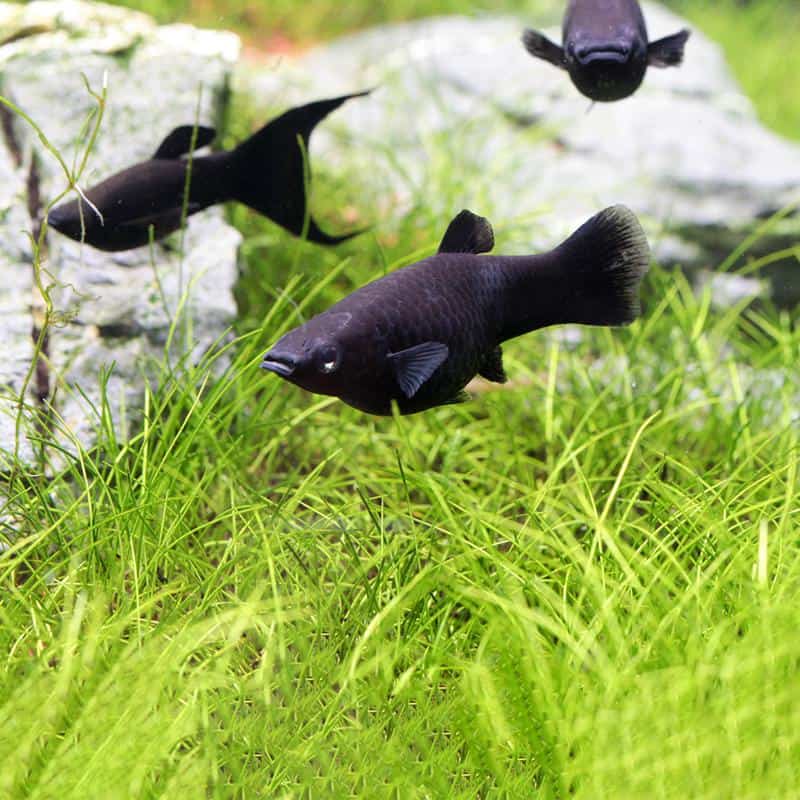
Typically reaching a maximum length of 3–5 inches (7–12 cm), black mollies are tiny species of fish. However, a black molly fish’s eventual size may vary depending on a number of variables, like its nutrition, habitat, and heredity.
Black molly fish females frequently become slightly bigger than males, especially throughout pregnancy. Females that are pregnant may evidently have a bigger abdomen, giving them an enormous appearance than males.
It is also important to remember that the size of black molly fish changes based on the kind or mutation. You should conduct research on the particular variant of black molly fish you are interested in order to determine its size and growth potential. Different species of black molly fish may be larger or smaller than others.
What Is the Average Life Expectancy of A Black Molly?
When kept under ideal conditions, black molly fish usually live for three to five years on average. Black molly fish may live up to or even more than seven years with the right care and attention.
What Are the Tank Size Requirements for Black Molly?

Black molly fish are relatively small and do not require a large tank compared to some other fish species. They still require adequate room to swim and grow, and the size of their tank may vary depending on a variety of factors, such as how many fish you intend to maintain and their individual sizes.
A small group of 3–4 black molly fish should have a minimum tank size of 30 gallons as a general recommendation. To comfortably fit everyone, you might need a larger tank if you intend to have a larger group of fish or if the tank also contains other species.
It is also important to note that black molly fish are active swimmers and appreciate plenty of open space to swim and explore. Adding decorations and plants to the tank can provide hiding places and additional areas for the fish to swim around.
What Is the Ideal Tank Condition for Black Molly?

Creating and maintaining optimal tank conditions is crucial for the health and well-being of black molly fish. Following are some important things to take into account when setting up and maintaining a black molly tank:
- Temperature: Black molly fish are tropical fish and need water that is between 70 and 82 °F (21 and 28° C). Monitor the water temperature with an accurate aquarium thermometer and adjust the heater as needed.
- Water quality: To survive, black molly fish need clean, well-maintained water since they are sensitive to bad water quality. Keep the water quality within safe and ideal parameters by performing regular water changes as needed and routinely testing the water parameters, such as pH, ammonia, nitrite, and nitrate levels.
- Filtration: Preserving optimum water quality in a black molly tank requires the use of a high-quality aquarium filter. In order to work at its best, the filter has to fit correctly for the tank and be cleaned and maintained often.
- Lighting: Black molly fish do not require intense lighting, but they do need some light to help maintain their natural diurnal rhythms. Your fish can get sufficient lighting with a regular aquarium light set on a timer.
- Decorations: Black molly fish appreciate plenty of hiding places and areas to explore in their tank. Adding live or artificial plants, rocks, and other decorations can help create a natural and stimulating environment for your fish.
The long-term well-being and joy of your black molly fish rely on ensuring an environment that is healthy and clean for them.
What Does Black Molly Eat?
In the wild surroundings, black molly fish are omnivore creatures and eat a variety of foods. They will flourish on a varied diet in captivity that includes both live or frozen foods and commercial fish foods. You may feed black molly fish the following things:
- Flakes or pellets: Black molly fish prosper on a diet consisting primarily of premium commercial fish feeds made for tropical fish. Choose products with a healthy mix of protein, fat, and fiber.
- Live or frozen foods: Black molly fish prefer live or frozen feeds that consist of brine shrimp, bloodworms, daphnia, and mosquito larvae. You may buy these kinds of foods either online or at your neighborhood pet shop.
- Vegetables: Black molly fish will also eat blanched vegetables such as spinach, lettuce, and zucchini. These meals give necessary fiber and minerals and may assist your fish’s gastrointestinal system stay fit.
To make sure that your black molly fish get all the nutrients they require to be healthy and develop, you must offer them a balanced and diverse diet.
Avoid overfeeding your fish by giving them little amounts of food two to three times each day. Bad tank water quality and health issues might result from overfeeding.
Can Black Molly Eat Small Fish?
If you plan to keep black molly fish with other fish in the same tank, it is important to choose compatible species that have similar temperaments and dietary needs. To prevent anxiety or violence, keep them away from extremely small fish and aggressive or territorial creatures.
How Many Black Mollies Should You Have?
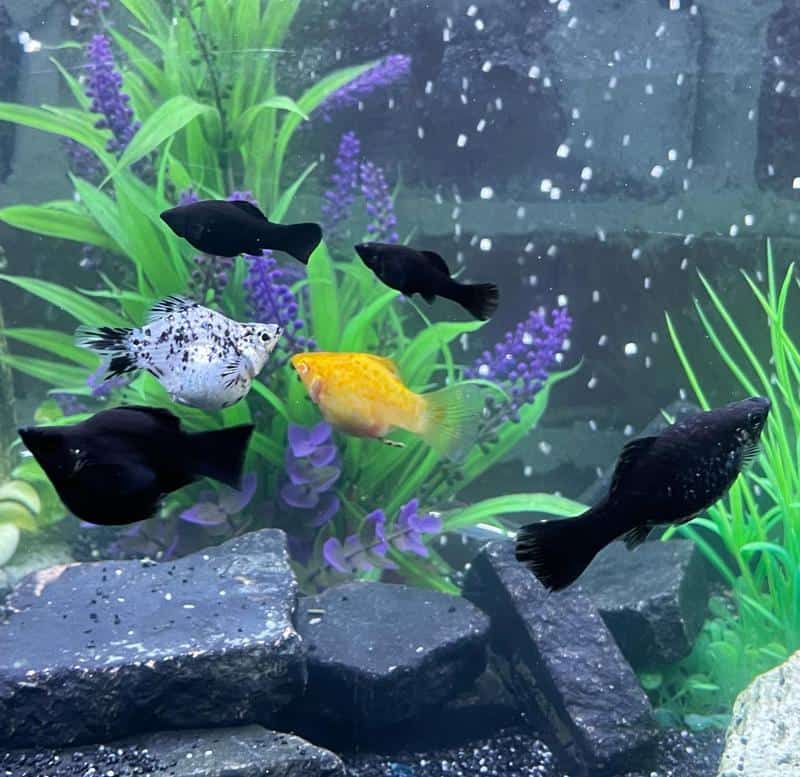
You ought to offer at least 2-3 gallons of water per inch of adult fish as a general rule. So, 5–6 mature black molly fish, each measuring around 3-5 inches in length, may live in a 50-gallon tank.
It is crucial to take your black molly fish’s sex ratio into account. It is advised that you keep more females than males since males might be hostile toward females. This will reduce hostility and create social harmony. The optimal ratio is 2-3 females to 1 male.
It is crucial to gradually introduce additional fish to your tank in order to prevent overloading the biological filtering system and triggering an ammonia surge. To guarantee that the water quality is safe and stable, introduce additional fish gradually over a period of several weeks.
Keep in mind that every fish is different, and they could have distinct demands and personalities. Always observe your black molly fish for signs of stress, illness, or aggression, and be prepared to adjust the tank conditions or group dynamics whenever necessary to keep your fish healthy and happy.
Is Black Molly Aggressive?
Black molly fish usually remain peaceful and not aggressive toward other fish in the aquarium. However, like every other fish, they can become aggressive under certain circumstances, such as during breeding or when defending their territory or hiding spots.
During the breeding season, male black molly fish can occasionally get aggressive with other males or females. They might nip or scare away other fish, stressing or hurting them.
It is advised to maintain more females than males in the tank to reduce aggressiveness, as well as plenty of plants and hiding places to help conceal territorial boundaries.
Additionally, distressed black molly fish may turn hostile toward other fish if the tank conditions are not ideal. Stress-inducing elements might include insufficient hiding places,overstocking, and poor water quality.
You may assist in lowering stress and reducing the possibility of violence by providing a well-maintained and adequately sized tank with lots of hiding locations and clean, well-oxygenated water.
Also Read:
FAQs
Are Black Molly Fish Capable of Surviving in A Bowl or Tiny Tank?
No, black molly fish require a spacious aquarium with adequate filtration and room to swim and hide. The conditions essential for their health and well-being cannot be provided by a bowl or tiny tank.
How Is Black Molly Fish Bred?
Black molly fish reproduce by giving birth to live young, making breeding them quite simple. Provide a separate breeding tank with lots of hiding places and slightly warmer water at 78–82°F to promote breeding.
Introduce a male and female pair, and provide them with a wide range of nutritious meals. The female will give birth to fry around four weeks after mating.
Can Black Molly Fish Survive in Brackish Water?
Yes, black molly fish can adapt to brackish water conditions which is a mix of freshwater and saltwater. However, it is crucial to gradually adapt them to the increased salt levels and to carefully monitor the water quality.
How Often Should You Feed Black Molly Fish?
Small meals two to three times a day should be given to black molly fish. Overfeeding can result in poor water quality and health issues, so it is crucial to only give them as much food as they can eat in a short period of time.
Conclusion
The black molly fish is a well-known freshwater species recognized for its stunning black color and friendly behavior. They are a fantastic choice for beginning aquarists since they are quite simple to take care of and have a number of unique behaviors that are fun to watch.
Although they are often hardy fish, it is still necessary to provide them with a clean, well-kept aquarium environment as well as diverse food that fits their nutritional demands. Additionally, it is important to bear in mind that Black Molly fish are sociable animals that flourish in groups; thus, it is advised to maintain them in groups of at least three.
Overall, Black Molly fish are a wonderful addition to any freshwater aquarium. Given the right care, they may survive for many years and give their owners countless hours of entertainment.
